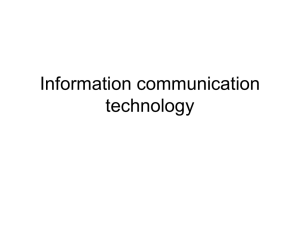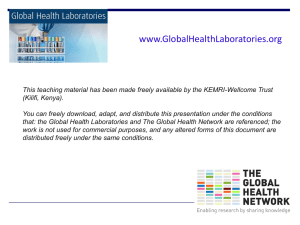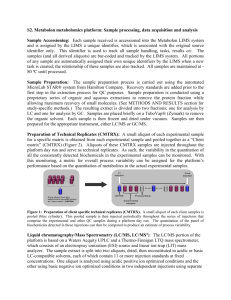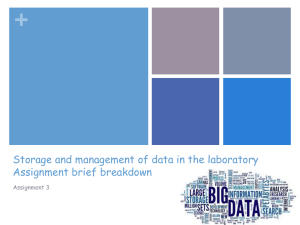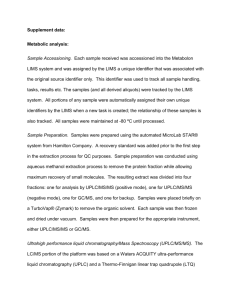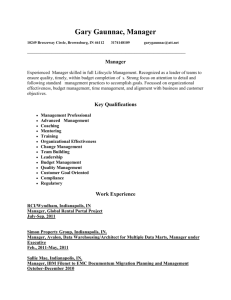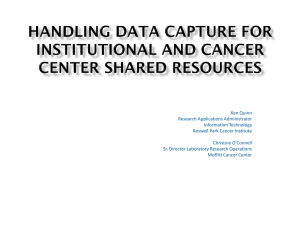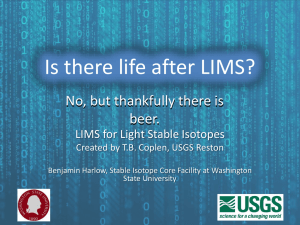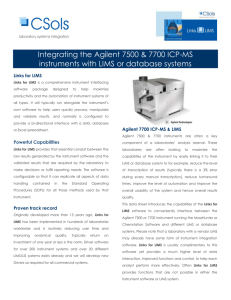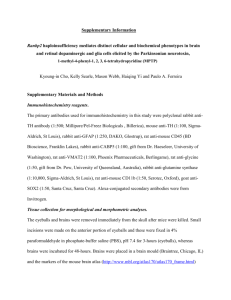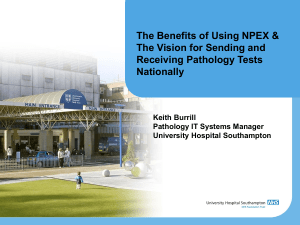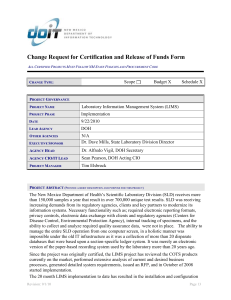Workshop Outline
advertisement
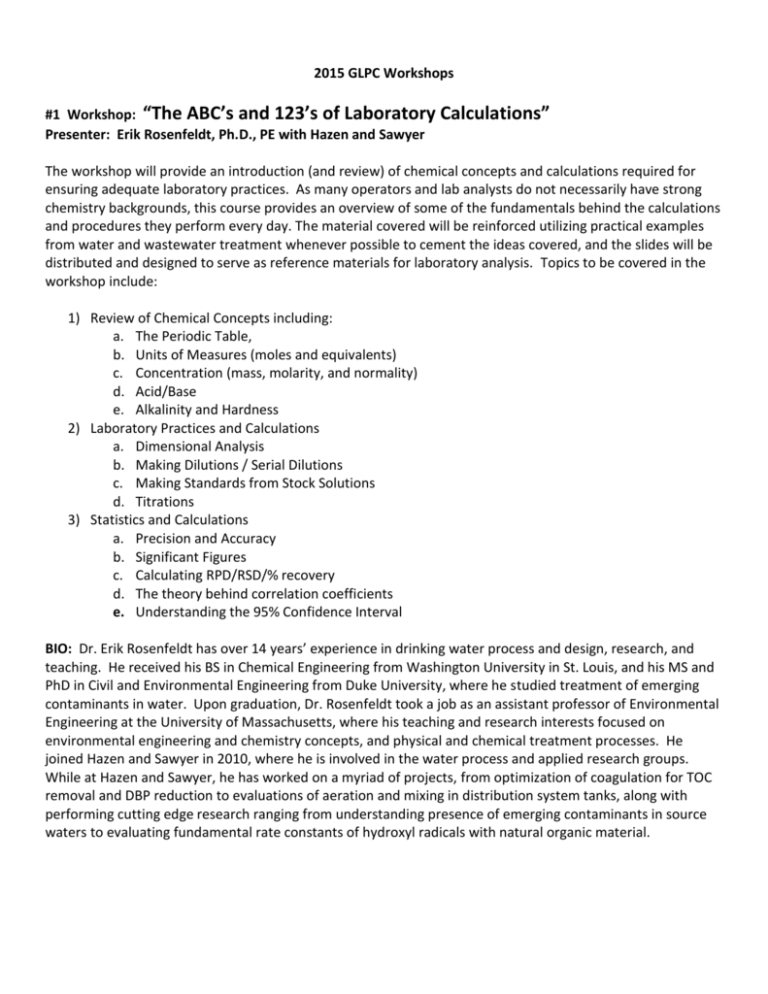
2015 GLPC Workshops #1 Workshop: “The ABC’s and 123’s of Laboratory Presenter: Erik Rosenfeldt, Ph.D., PE with Hazen and Sawyer Calculations” The workshop will provide an introduction (and review) of chemical concepts and calculations required for ensuring adequate laboratory practices. As many operators and lab analysts do not necessarily have strong chemistry backgrounds, this course provides an overview of some of the fundamentals behind the calculations and procedures they perform every day. The material covered will be reinforced utilizing practical examples from water and wastewater treatment whenever possible to cement the ideas covered, and the slides will be distributed and designed to serve as reference materials for laboratory analysis. Topics to be covered in the workshop include: 1) Review of Chemical Concepts including: a. The Periodic Table, b. Units of Measures (moles and equivalents) c. Concentration (mass, molarity, and normality) d. Acid/Base e. Alkalinity and Hardness 2) Laboratory Practices and Calculations a. Dimensional Analysis b. Making Dilutions / Serial Dilutions c. Making Standards from Stock Solutions d. Titrations 3) Statistics and Calculations a. Precision and Accuracy b. Significant Figures c. Calculating RPD/RSD/% recovery d. The theory behind correlation coefficients e. Understanding the 95% Confidence Interval BIO: Dr. Erik Rosenfeldt has over 14 years’ experience in drinking water process and design, research, and teaching. He received his BS in Chemical Engineering from Washington University in St. Louis, and his MS and PhD in Civil and Environmental Engineering from Duke University, where he studied treatment of emerging contaminants in water. Upon graduation, Dr. Rosenfeldt took a job as an assistant professor of Environmental Engineering at the University of Massachusetts, where his teaching and research interests focused on environmental engineering and chemistry concepts, and physical and chemical treatment processes. He joined Hazen and Sawyer in 2010, where he is involved in the water process and applied research groups. While at Hazen and Sawyer, he has worked on a myriad of projects, from optimization of coagulation for TOC removal and DBP reduction to evaluations of aeration and mixing in distribution system tanks, along with performing cutting edge research ranging from understanding presence of emerging contaminants in source waters to evaluating fundamental rate constants of hydroxyl radicals with natural organic material. “Back to Basics: pH, ISE, Conductivity, Turbidity, and Spectrophotometer” #2 Workshop: Presenter: Kelly Sweazea with ThermoScientific This workshop will demonstrate the basics of using Ion Specific Electrodes (pH, Conductivity) and the Spectrophotometer. Discussion will cover methodology and troubleshooting BIO: Kelly Sweazea, Thermo Scientific Electrochemistry Products Technical Sales Manager, is the technical resource available to government, education, and industry research laboratory technicians and scientists using Thermo Scientific electrochemistry products in North Carolina, Virginia, Maryland and Delaware. She has represented quality laboratory equipment product lines in various Southeast and Mid-Atlantic regions since 2003. #3 Workshop: “Microbiology Methods for Wastewater Laboratories” Presenters: John Allen and Saiful Islam, Fairfax County Gil Ditcher, IDEXX ?? This is workshop will introduce wastewater microbiology and various certified methods for bacterial testing of wastewater, including quality control procedures and compliance requirements. The core competency for this presentation is “Required Capabilities for Collecting Samples and Interpreting Laboratory Analyses” Knowledge of biological science Ability to recognize abnormal analytical results Knowledge of sampling and preservation procedures Knowledge of laboratory equipment and procedures Knowledge of normal characteristics of wastewater BIOs #4 Workshop: “VPDES Permit DMR Reporting” Presenters: Wayne Staples, Jason T. Spicer with DEQ Workshop Outline: 1.0 Permits, Records and Reports 1.1 Definitions 1.2 VPDES Permits 1.3 General Requirements A. Access B. Operations & Maintenance C. Recordkeeping D. Records Retention 1.4 Reporting A. Unusual/Extraordinary Discharge B. 24 Hour Reporting C. Bypasses D. Compliance Schedules E. Discharge Monitoring Reports (DMR) 1.5 Specific Reporting Requirements A. Effluent Monitoring B. Effluent Limitations C. Compliance Schedules D. Special Conditions E. Licensed Operator Requirements F. Quantification Levels G. Reporting Calculations 1.6 DMR Exa BIO’s ?? Wastewater Operations Specialist Operator Training Program Office of Water Compliance Water Division Department of Environmental Quality Wayne.Staples@deq.virginia.gov Telephone: (804) 698-4106 Wastewater Operations Specialist Operator Training Program Office of Water Compliance Water Division Department of Environmental Quality Jason.Spicer@deq.virginia.gov Telephone: (804) 698-4143 #5 Workshop: “ LIMS in the Cloud” Dr. Christine Paszko, Vice President, Accelerated Technology Laboratories, Inc. cpaszko@atlab.com 910.603.3410 Technology such as SaaS (Software as a Service) is allowing smaller laboratories access to LIMS and data management solutions that they may not have previously had the resources to fund or manage. There are also larger laboratories that perform ROI calculations and determine that it is more cost effective to leverage SaaS (private cloud) than to host the LIMS internally. They examine the cost of a full time IT resource/s to manage and maintain the database/web server, the networks (LAN/WAN), the cost of the hardware (typically replaced every 3-4 years), maintenance (performing daily backups, applying service packs, monitoring the system, etc.), cost of electricity, the data base licenses (Windows OS, SQL Server, backup software, antivirus software, etc.) and providing 100% uptime. There are many small utilities (both water and wastewater laboratories) that maintain quality standards in the laboratory to generate quality data. They could greatly benefit (saving time and money) from automated systems to facilitate their workload in managing the items below, SaaS provides an attractive option. Sample Tracking (creating collection kits) barcoding Leveraging mobile technology for field data collection and real time communication Scheduling (to ensure that compliance and routine monitoring samples are collected) QA/QC Data (organize control data, control charts as well as audit reports) Managing their SOPs for the tests/methods they use (for their audits) Interfacing instruments so that data doesn’t have to be manually transcribed Managing chemical inventory in the laboratory (lot #, expiration date, tracking usage, etc.) Managing instrument maintenance and calibration records Handling customer complaints – Managing CAPAs (Corrective and Preventative Actions) Tracking employee training records and expiration dates Real time web reporting to internal and external customers Reporting (Electronic – automated state reporting –SDWIS, NPDES DMR, others) LIMS Selection: The Good, the Bad and the Ugly Today’s laboratories are tasked with providing quality data, rapidly, to the latest SOPs, in a certified environment, and cost effectively. There are so many requirements that have been placed on the environmental laboratory over the years. In today’s modern laboratory, it is very difficult to maximize productivity, generate quality data, quickly disseminate that data, maintain your sanity and manage all of the paperwork and documents that are required for regulatory compliance without a LIMS. Laboratory Managers typically do not have an IT background, so when they are considering LIMS systems, they often can only evaluate features and functions and not the underlying technology. Conversely IT managers typically evaluate the technology, but lack the laboratory expertise to carefully evaluate the features and functions. To experience a successful LIMS selection and deployment, it takes a team and education for everyone on what the key considerations should be included in the selection process of both premise based and hosted LIMS solutions. This portion of the presentation will cover the PO, RFQ, RFI, or RFP process, key considerations (questions to ask) to final selection. BIO: Dr. Christine Paszko currently serves as Vice President of Sales and Marketing at (ATL) Accelerated Technology Laboratories, Inc. ATL is a Leader in LIMS which has significant market share in water/wastewater laboratories with Sample Master® and TITAN® LIMS, and iMobile for field data collection. Dr. Paszko has a BS in Medical Technology from the University of New York at Buffalo, with a Ph.D. in Molecular Microbiology with a minor in Biochemistry from the University of Maryland. She has worked in the laboratory for over 15 years, where she was an end-user of LIMS solutions, working in R&D, Clinical and Water Quality Laboratories. She has over 20 years of LIMS expertise; she has authored a book on LIMS, written a chapter on LIMS in the chemical industry and has over 3 dozen publications on LIMS and Laboratory Automation. She has also been an invited speaker at over 50 events to discuss LIMS, trends in Laboratory Automation, Best Practices and Considerations in LIMS Selection. “The Ins and Outs of the Proficiency Testing (PT) Program, Proper Use of Certified Reference Materials and Reagent Traceability” #6 Workshop: Presenters: Stacie Metzler with HRSD and Shawn Kassner with Phenova Proficiency Testing (PT), the proper use of Certified Reference Materials and Reagent Traceability are all key elements of a NELAP/VELAP complaint quality system. This workshop will give attendees a better understanding of the PT program and the requirements PT providers must adhere to in order to produce PT samples that meet NELAP/VELAP Program requirement. Fields of Proficiency Tables are tools for both laboratories and PT Providers to use when preparing and analyzing PT samples, and an explanation of how these tables are developed and how a laboratory can use them as a tool when handling PTs will be discussed. In addition, the proper use of Certified Reference Materials (CRM)s and the importance of Reagent Traceability will be discussed. By using these two quality system requirements together a laboratory has the tools to ensure analyses are performed correctly, analytical systems are operating correctly, and an easy way to complete troubleshooting when there are quality control failures. Stacie Metzler BIO: Stacie holds a Bachelor’s of Science degree from Ohio University. She has worked as an environmental laboratory professional with Hampton Roads Sanitation District in the Central Environmental Laboratory for 21 years and recently took the position of Chief of the Laboratory. Previous to this, Stacie served as Quality Assurance Manager for the 15 years. During her time with Hampton Roads Sanitation District she has led the effort to develop and implement a NELAC compliant quality system. In addition Stacie has been involved with many activities external to HRSD including: Various Committee roles with the NELAC Institute Current Chair of the WEF Lab Practices Committee Current Chair of the WEF Operations Challenge Committee Past President of the Virginia Water Environment Association. Shawn Kassner – BIO: Shawn Kassner is the Senior Product Manager for Phenova. He has been involved in the analysis of environmental samples for 8 years and proficiency testing programs for over 17 years prior to joining Phenova. He is the current chair of the TNI Laboratory Proficiency Testing Expert Committee, and contributing member of Consensus Development Executive Committee, and the Proficiency Testing Program Executive Committee. He obtained his Bachelor of Science Degree in Biology from the Metropolitan State University of Denver.
